Below are 100 Examples of Active Passive Voice in English. Let us first discuss active and passive voice.
Active and Passive Voice! What’s the Difference?
Active Voice
We use active voice in our daily speech and normal conversation. Active voice is used when we have to describe a situation. We will use active voice when describing a situation from the perspective of the other person. The other person is basically the one performing the action. In active voice, the subject is the person, and action is referred to as the object. Some examples of active voice are:
- The cat killed the mouse.
- The man cut down the tree.
- Columbus discovered America.
- His teacher praises him
- The boy teased the dog.
Passive Voice
When the object is affected by the action, we use passive voice. A verb is in the passive voice when its form shows that something is done to the person or thing denoted by the subject. The passive voice may be used when the doer is not known or when for any reason we don’t want to name the doer. Some Examples of Passive Voice are:
- He was praised by his father.
- The horse was frightened by the noise.
- Now a word was spoken by Sara.
- The road was lined with people.
Another Interesting Lesson: Active Voice and Passive Voice Examples With Answers
When to Use Active Voice?
The active voice is usually the best choice for most sentences. It is more concise and direct than the passive voice. In addition, it is usually less confusing for readers. Here are a few examples of when to use the active voice:
- When the subject of the sentence is doing the action:
- I am writing this blog post.
- When you want to be concise and direct:
- Passive voice can be wordy and confusing for readers.
- When you want to emphasize the subject of the sentence:
- Active voice puts the focus on the subject of the sentence.
- When you want to show that someone is in control:
The active voice can make it seem like someone is in control of a situation.
When to Use Passive Voice?
There are times when the passive voice is the better choice. Here are a few examples:
- When you want to emphasize the object of the sentence:
- The passive voice can make it seem like the object of the sentence is more important than the subject.
- When you want to hide the identity of the subject:
- The passive voice can be used when you don’t want to reveal the identity of the subject.
- When you want to avoid making someone look bad:
- Sometimes, you might not want to make someone look bad by using the active voice. In this case, you can use the passive voice instead.
- When the subject is unknown:
- Sometimes, the subject of a sentence is unknown. In this case, you can use the passive voice to avoid revealing your identity.
Now that you know when to use active and passive voice, let’s take a look at some examples!
Formation of Passive Voice
The passive voice is formed with a suitable tense of the verb followed by the past participle. Study this table:
| Tense (or Modal + base) | Active Voice | Passive Voice |
| Simple present | take, takes | am taken, is taken, are taken |
| Present continuous | am taking, is taking, are taking | am taken, is taken, are taken |
| Present perfect | has taken, have taken | has been taken, have been taken |
| Simple past | took | was taken, were taken |
| Past continuous | was taking, were taking | was being taken, were being taken |
| Past perfect | had taken | had been taken |
| Simple future | will take, shall take | will be taken, shall be taken |
| Can/may/must, etc. + base | can take, must take | can be taken, must be taken |
Active and Passive Voice Chart
| Tense | Active Voice | Passive Voice |
|---|---|---|
| Simple Present | I eat an apple. | An apple is eaten by me. |
| Present Continuous | I am eating an apple. | An apple is being eaten by me. |
| Present Perfect | I have eaten an apple. | An apple has been eaten by me. |
| Present Perfect Continuous | I have been eating an apple. | An apple has been eaten by me. |
| Simple Past | I ate an apple. | An apple was eaten by me. |
| Past Continuous | I was eating an apple. | An apple was being eaten by me. |
| Past Perfect | I had eaten an apple. | An apple had been eaten by me. |
| Past Perfect Continuous | I had been eating an apple. | An apple had been eaten by me. |
| Simple Future | I will eat an apple. | An apple will be eaten by me. |
| Future Continuous | I will be eating an apple. | An apple will be eaten by me. |
| Future Perfect | I will have eaten an apple. | An apple will have been eaten by me. |
| Future Perfect Continuous | I will have been eating an apple. | An apple will have been eaten by me. |
100 Examples of Active and Passive Voice
Below are examples of active voice and passive voice:
Active Voice:– She is going to deliver the letters.
Passive Voice:– The letters are going to be delivered.
Active Voice:– I’m going to make a cake.
Passive Voice:– A cake is going to be made.
Active Voice:– She will deliver the letters.
Passive Voice:– The letters will be delivered.
Active Voice:– I have made a cake.
Passive Voice:– A cake has been made.
Active Voice:– Sapna helps the old lady.
Passive Voice:– The old lady was helped by Sapna.
Active Voice:– She must deliver the letters.
Passive Voice:– The letters must be delivered.
Active Voice:– She delivered the letters.
Passive Voice:– The letters were delivered.
Active Voice:– I was making a cake.
Passive Voice:– A cake was being made.
Active Voice:– Did you show me the dress?
Passive Voice:– Was I shown the dress by you?
Active Voice:– She has to deliver the letters.
Passive Voice:– The letters have to be delivered.
Active Voice:– They called off the meeting.
Passive Voice:– The meeting was called off.
Active Voice:– Sue changed the flat tire.
Passive Voice:– The flat tire was changed by Sue.
Active Voice:– They will send him away to school.
Passive Voice:– He will be sent away to school.
Active Voice:– He was writing a letter.
Passive Voice:– A letter was being written by him.
Active Voice:– She had delivered the letters.
Passive Voice:– The letters had been delivered.
Active Voice:– I should have made a cake.
Passive Voice:– A cake should have been made.
Active Voice:– I was playing video games.
Passive Voice:– The video games were being played by me.
Active Voice:– The choir really enjoys that piece.
Passive Voice:– That piece is really enjoyed by the choir.
Active Voice:– I invited you to the party.
Passive Voice:– You were invited by me to the party.
Active Voice:– Tom painted the entire house.
Passive Voice:– The entire house was painted by Tom.
Active Voice:– She has delivered the letters.
Passive Voice:– The letters have been delivered.
Active Voice:– I must make a cake.
Passive Voice:– A cake must be made.
Active Voice:– I am eating breakfast.
Passive Voice:– The breakfast is being eaten by me.
Active Voice:– Mother is cooking lunch in the kitchen.
Passive Voice:– Lunch is being cooked in the kitchen.
Active Voice:– We will be watching the match.
Passive Voice:– The match will be being watched by us.
Active Voice:– I’m making a cake.
Passive Voice:– A cake is being made.
Active Voice:– The two kings are signing the treaty.
Passive Voice:– The treaty is being signed by the two kings.
Active Voice:– He will play the match.
Passive Voice:– The match will be played
Active Voice:– I make a cake.
Passive Voice:– A cake is made.
Active Voice:– He loves me.
Passive Voice:– I am loved by him.
Active Voice:– Michael is baking a brownie.
Passive Voice:– A brownie is being baked by Michael.
Active Voice:– Mark has tricked me.
Passive Voice:– I have been tricked by Mark
Active Voice:– I have played the game.
Passive Voice:– A game has been played by me.
Active Voice:– She was delivering the letters.
Passive Voice:– The letters were being delivered.
Active Voice:– I will make a cake.
Passive Voice:– A cake will be made.
Active Voice:– His grandmother looked after him.
Passive Voice:– He was looked after by his grandmother.
Active Voice:– She delivers the letters.
Passive Voice:– The letters are delivered.
Active Voice:– I made a cake.
Passive Voice:– A cake was made.
Active Voice:– She is delivering the letters.
Passive Voice:– The letters are being delivered.
Active Voice:– I had made a cake.
Passive Voice:– A cake had been made.
Active Voice:– I gave him a book for his birthday.
Passive Voice:– He was given a book for his birthday.
Active Voice:– Harry ate six shrimp at dinner.
Passive Voice:– At dinner, six shrimp were eaten by Harry.
Active Voice:– Tom painted the entire house.
Passive Voice:– The entire house was painted by Tom.
Active Voice:– The mother is feeding the baby.
Passive Voice:– The baby is being fed by the mother.
Active Voice:– Mom read the novel in one day.
Passive Voice:– The novel was read by Mom in one day.
Active Voice:– I read an interesting novel.
Passive Voice:– An interesting novel is read.
Active Voice:– She will deliver the packages.
Passive Voice:– The packages will be delivered by her.
Active Voice:– We have published a new magazine.
Passive Voice: – A new magazine has been published.
Active Voice:– He is cleaning the room.
Passive Voice:– The room is being cleaned by him.
Active Voice:– They will have finished the project by Monday.
Passive Voice:– The project will have been finished by Monday.
Active Voice:– I am writing a novel.
Passive Voice:– A novel is being written by me.
Active Voice:– I will have made a cake by tomorrow.
Passive Voice:– A cake will have been made by tomorrow.
Active Voice:– The cat chased the mouse.
Passive Voice:– The mouse was chased by the cat.
Active Voice:– She wrote a beautiful song.
Passive Voice:– A beautiful song was written by her.
Active Voice:– The teacher explained the lesson to the students.
Passive Voice:– The lesson was explained to the students by the teacher.
Active Voice:– The company developed a new product.
Passive Voice:– A new product was developed by the company.
Active Voice:– The kids played in the park.
Passive Voice:– The park was played in by the kids.
Active Voice:– He fixed the broken car.
Passive Voice:– The broken car was fixed by him.
Active Voice:– The chef prepared a delicious meal.
Passive Voice:– A delicious meal was prepared by the chef.
Active Voice:– The company launched a new advertising campaign.
Passive Voice:– A new advertising campaign was launched by the company.
Active Voice:– They built a tall skyscraper.
Passive Voice:– A tall skyscraper was built by them.
Active Voice:– She planted flowers in the garden.
Passive Voice:– Flowers were planted in the garden by her.
Active Voice:– The team won the championship.
Passive Voice:– The championship was won by the team.
Active Voice:– The doctor performed the surgery successfully.
Passive Voice:– The surgery was performed successfully by the doctor.
Active Voice:– The police caught the thief.
Passive Voice:– The thief was caught by the police.
Active Voice:– He painted a beautiful landscape.
Passive Voice:– A beautiful landscape was painted by him.
Active Voice:– The students completed the assignment on time.
Passive Voice:– The assignment was completed on time by the students.
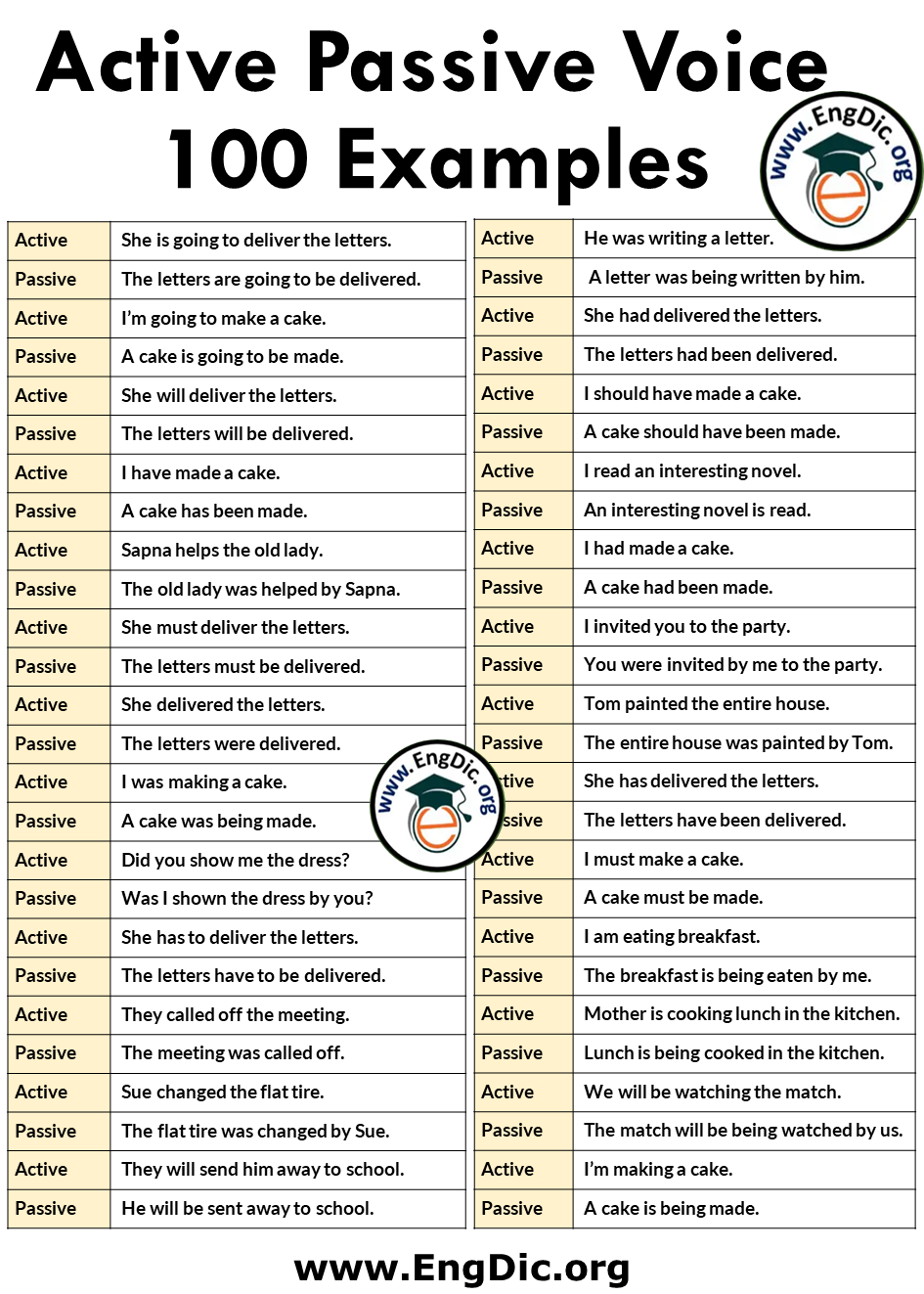
Active and Passive Voice Examples for All Tenses
Here are some examples of active and passive voice for all tenses in English:
1. Simple Present Tense:
Active Voice: The dog chases the cat.
Passive Voice: The cat is chased by the dog.
2. Present Continuous Tense:
Active Voice: I am eating breakfast.
Passive Voice: Breakfast is being eaten by me.
3. Present Perfect Tense:
Active Voice: She has written a letter.
Passive Voice: A letter has been written by her.
4. Present Perfect Continuous Tense:
Active Voice: They have been painting the house for three hours.
Passive Voice: The house has been being painted by them for three hours.
5. Simple Past Tense:
Active Voice: She visited her grandmother last week.
Passive Voice: Her grandmother was visited by her last week.
6. Past Continuous Tense:
Active Voice: I was watching TV when she arrived.
Passive Voice: TV was being watched by me when she arrived.
7. Past Perfect Tense:
Active Voice: They had finished their homework before dinner.
Passive Voice: Homework had been finished by them before dinner.
8. Past Perfect Continuous Tense:
Active Voice: He had been studying for four hours before he took a break.
Passive Voice: Studying had been done by him for four hours before he took a break.
9. Simple Future Tense:
Active Voice: I will finish the project by tomorrow.
Passive Voice: The project will be finished by me by tomorrow.
10. Future Continuous Tense:
Active Voice: We will be working on the assignment at 2 pm.
Passive Voice: The assignment will be being worked on by us at 2 pm.
11. Future Perfect Tense:
Active Voice: By this time next week, I will have finished the book.
Passive Voice: The book will have been finished by me by this time next week.
12. Future Perfect Continuous Tense:
Active Voice: She will have been living in Paris for 5 years next month.
Passive Voice: Paris will have been lived in by her for 5 years next month.
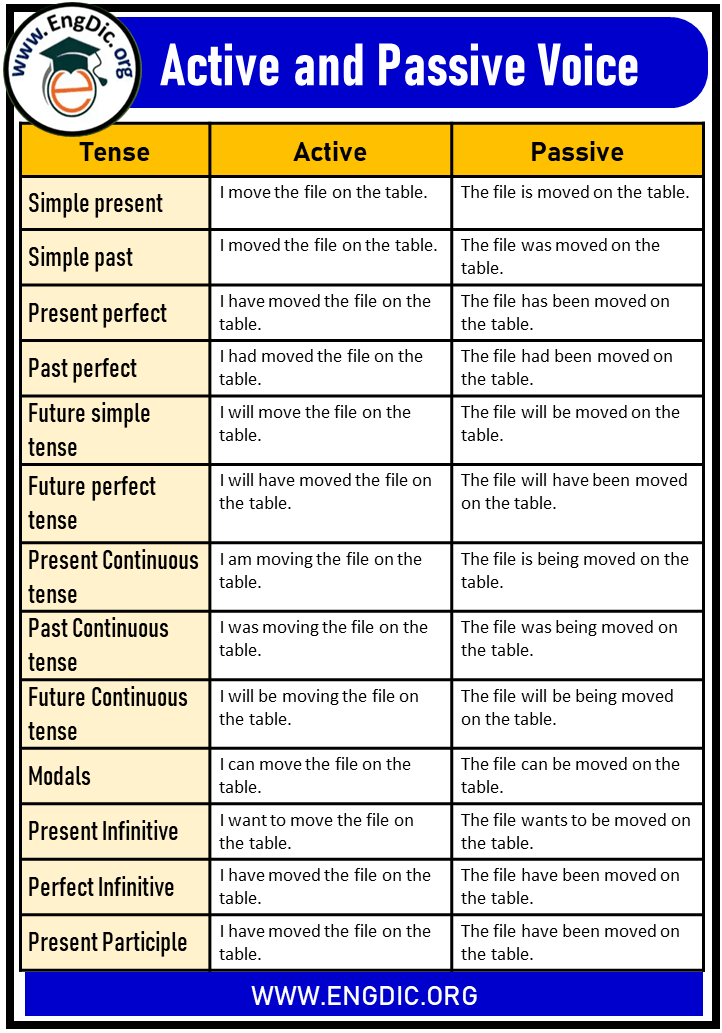
Active and Passive Voice Exercises
Related: 25 Active/Passive Examples with Answers
Exercise 1: Convert the following sentences from active voice to passive voice.
John ate the pizza.
Passive: The pizza was eaten by John.
The teacher gave the students an assignment.
Passive: An assignment was given to the students by the teacher.
Someone stole my bike.
Passive: My bike was stolen by someone.
The company will release a new product next month.
Passive: A new product will be released by the company next month.
The dog chased the cat.
Passive: The cat was chased by the dog.
Exercise 2: Convert the following sentences from passive voice to active voice.
The cake was baked by Mary.
Active: Mary baked the cake.
The book was written by J.K. Rowling.
Active: J.K. Rowling wrote the book.
The car was repaired by the mechanic.
Active: The mechanic repaired the car.
The film was directed by Steven Spielberg.
Active: Steven Spielberg directed the film.
The letter was typed by Sarah.
Active: Sarah typed the letter.
More Related:
Download this Lesson in PDF

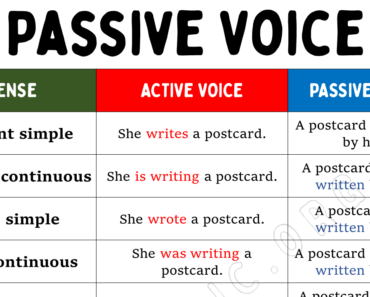
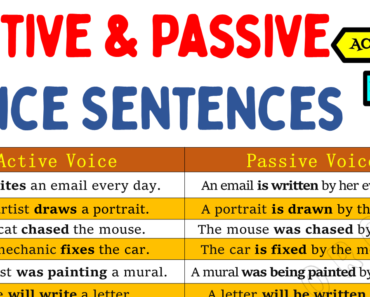
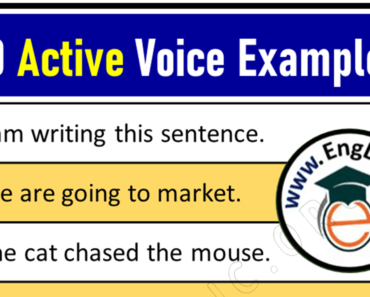
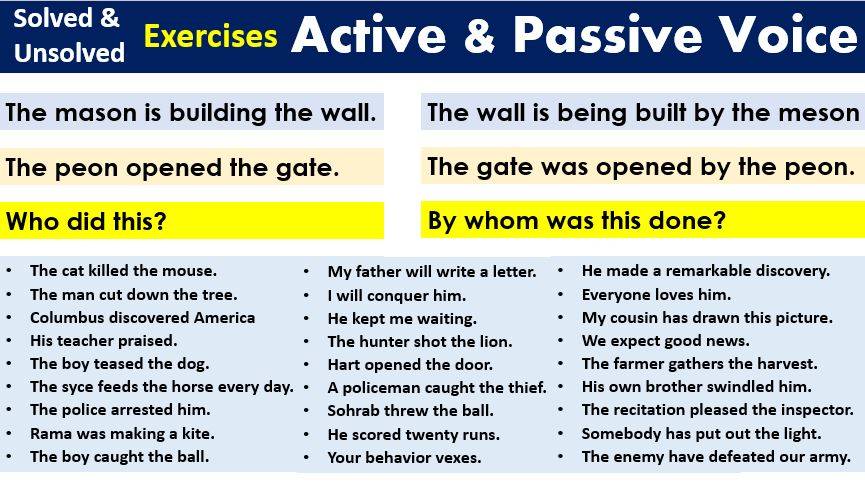
![200 Active and Passive Voice Examples with Answers [+PDF] 200 Active and Passive Voice Examples with Answers [+PDF]](https://engdic.org/wp-content/uploads/2022/03/200-Active-and-Passive-Voice-Examples-370x297.png)
